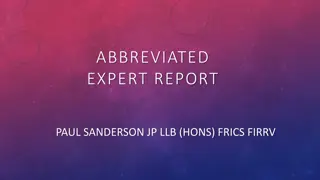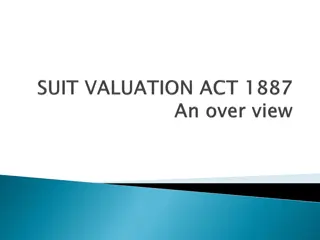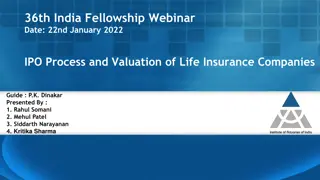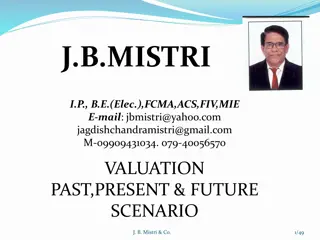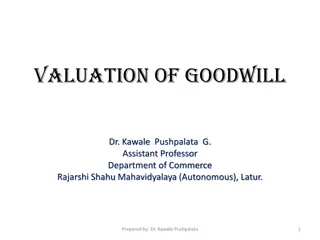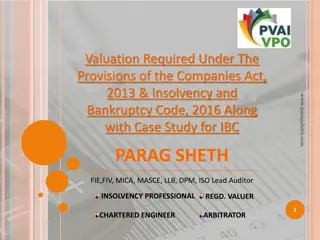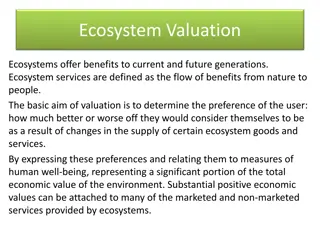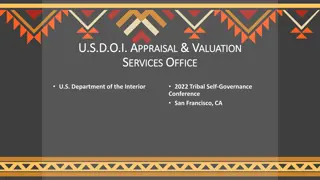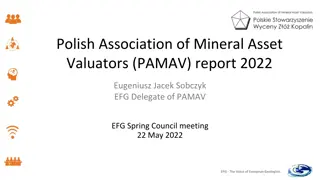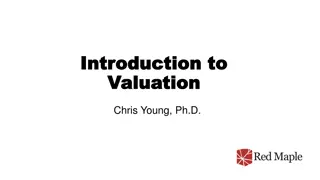
Equitable Value in Valuation: Insights and Principles
Dive into the concept of Equitable Value (EV) in valuation practices, exploring its definition, significance, and role in structuring transactions. Learn how EV helps in reflecting and reconciling interests of parties involved, ensuring a fair division of gains.
Download Presentation

Please find below an Image/Link to download the presentation.
The content on the website is provided AS IS for your information and personal use only. It may not be sold, licensed, or shared on other websites without obtaining consent from the author. If you encounter any issues during the download, it is possible that the publisher has removed the file from their server.
You are allowed to download the files provided on this website for personal or commercial use, subject to the condition that they are used lawfully. All files are the property of their respective owners.
The content on the website is provided AS IS for your information and personal use only. It may not be sold, licensed, or shared on other websites without obtaining consent from the author.
E N D
Presentation Transcript
RSV CA Rajiv Singh FCA, CISA(USA), RV, LIII Director Union Bank of India Course Director IVCP
BOV, Levels of Value, Valuation Date , Subsequent Date , Valuation Principles , SOW and I & C Session 3 RSV
Impact of Transaction and Transportation cost while estimating Fair Value (IFRS 13) Transaction cost Transportation cost No Identification of PM Identification of MAM Measuring FV No Yes Yes No Yes RSV
Equitable Value (EV) Definition (IVS 2020): a) Is the estimated price b) For transfer of an asset or liability c) Between identified knowledgeable and willing parties d) That reflects the respective interest of those parties . EV requires assessment of the price that is fair between two specific, identified parties considering respective advantages or disadvantages that each will gain from the transaction. RSV
Equitable Value (EV) IVS 2017 renamed fair value as equitable value (same continues in IVS 2020) In this definition, fairness is in ethical sense (Fair = Equitable = Just) EV is a BOV associated with Value-in-exchange and used for structuring transactions No hypothetical assumption No exposure to market before valuation date RSV
Equitable Value (EV) Valuation is conducted with a view to reflect and reconcile interests of both parties in a best possible manner EV as a BOV is more relevant for a valuer acting as a consultant while structuring a transaction or where the market for the Subject Asset is not reliable (where law of one price is likely to a breakdown) RSV
Equitable Value (EV) IVB Equitable Value IVS Unless IVB > IVS there is no motivation in deal for the seller Gain = IVB - IVS Valuer role is to make a fair (just or equitable) division of gains resulting from the transaction RSV
Equitable Value (EV) There is no guidance as to how to distribute gain Gain Either divide equally Or in a fair proportion Goes back to Aristotle who first build a normative value (bargaining) now substituted by positivist theory of value. RSV
The Levels of Value Do the followings make sense to you? a) 100% controlling marketable value b) 100% controlling non-marketable value c) 55% controlling marketable value d) 55% controlling non-marketable value e) 20% minority marketable value f) 20% minority non-marketable value g) 10% non-controlling non-marketable value RSV
The Levels of Value Traditional view Strategic Value CV Control Premium DLOC or MID MMV or non-controlling marketable value DLOM NMV or non-controlling non- marketable value CV: Control Value MMV: Marketable Minority Value NMV: Non-marketable Minority Value RSV
The Levels of Value Expanded view Strategic Value SCV Strategic Premium Base Figure FCV Financial Control Premium DLOC or MID MMV Base Figure DLOM SCV: Strategic Control Value FCV: Financial Control Value NMV RSV
The Levels of Value Expanded view If base figure is the FCV then two discounts will give NMV If base figure is the MMV then adding control premium gives FCV and deducting DLOM gives NMV RSV
The Levels of Value a) Financial Control: What a financial buyer is able (or perhaps willing) to pay for control of a business. The buy is based on the ability of the buyer to extract a reasonable rate of return. b) Strategic Control: Strategic buyer can (and do) pay more for companies than financial buyers. The buyer is expecting to realize synergies from the acquisition. RSV
The Levels of Value The control premium data available in the market reflects the combination of: SCP FCP (Strategic Control Premium) (Financial Control Premium) Using control premium study data to calculate MID or DLOC in a FMV context is conceptually incorrect except where there are no synergy buyers. This overstate the extent of MID. RSV
The Levels of Value When MID derived from control premium study and is applied to FCV it will produce a value below MMV (for which no clear definition exists). This will understate the value RSV
The Levels of Value Approach 1: SCV Less: Synergy premium (30%) FCV (a) Less: MID or DLOC (20%) MMV Less: DLOM (30%) NMV INR 20 6 14 2.80 11.20 3.36 7.84 RSV
The Levels of Value Control share in an unlisted company may require DLOM (but not similar to minority shares) DLOM & DLOC are multiplicative and not additive 1- [(1-20%)*(1-30%)]= 44% RSV
The Levels of Value Approach 2: Step 1: Calculate MMV Step 2: a) Add: FCP and SCP to get FCV and SCV respectively b) Deduct: DLOM to get NMV RSV
The Levels of Value Income Approach Produces MMV or FCV/SCV? Minority CFs [CFs with the existing management] MMV *Controlling CFs [with control owners] FCV *It would produce SCV if synergies are also counted in the CFs. RSV
The Levels of Value Income Approach DCF produces MMV because discount rate is estimated by applying CAPM or build-up model which uses minority transaction data --- is a flawed concept All differences lie in CF and not much in the discount rate Generally, the differences in return from investment in freely tradeable minority interest and a controlling interest is not significant Control buyers pay premium to increase CFs and not because they expect lower return RSV
The Levels of Value Market Approach Market Approach Guideline publicly-traded comparable method [GPTCM] Comparable transaction method [CTM] MMV? FCV? SCV? RSV
The Levels of Value Market Approach In CTM, no premium adjustment is required as it is reflected in the Transaction price If CTM is used to value less than control interest, apply DLOC and may be DLOM The essential thought behind the traditional view is that the publicly traded value represents a MMV Eric Nath (1990) showed that many, if not most, company would be trading at control value or they would be subject to takeover attraction a contrarian view RSV
The Levels of Value Asset Based Approach or Cost Approach Asset methods reflects control over the assets and therefore a control value The control owner has hypothecation, mortgage or utilization of assets Do not apply control premium using this approach While valuing a less than controlling interest by asset approach apply DLOC the option of liquidating, RSV
The Levels of Value Standard of Value or Levels of value FMV or FV (IFRS 13) Consider DLOC & DLOM for estimation of a minority stake Investment Value FCP and SCP may form part of the acquisition premium FV (Legal) Generally DLOM & DLOC may not apply. premium is rarely applied. Control RSV
The Levels of Value Levels of value Control Value MMV Market Approach CTM Adjusted NAV Income Approach Control CFs Near Total Power Market Approach GPTCM Income Approach Minority CFs Little or no controlling power DLOM DLOC & DLOM NMV NMV Little or no power Little or no power RSV
Valuation date, Subsequent events and Report date Valuation Date: Value is time specific as of a given date . (IVS 2020) A specific point in time as of which the valuator s opinion of value applies . Significance of valuation date The value of an asset is estimated by reference to information available at that date Only the events or information (foreseeable) as of the valuation date should be considered known or knowable RSV
Valuation date, Subsequent events and Report date Valuation Date (VD) Report Date (RD) Case I: Current valuation VD RD March 31, 2020 June 30, 2020 RSV
Valuation date, Subsequent events and Report date Valuation Date (VD) Report Date (RD) Case II: Retrospective valuation VD RD April 1, 2006 June 30, 2020 RSV
Valuation date, Subsequent events and Report date Valuation Date (VD) Report Date (RD) Case III: Prospective valuation RD VD June 30, 2020 March 31, 2024 Only for internal purpose RSV
Valuation date, Subsequent events and Report date Prudence is assessed by referring to the state of the market at valuation date (no hindsight is allowed) Selling assets in a market with falling prices are not necessarily imprudent Prudent buyer/seller will act as per best market information as on the valuation date Transactions closer to the valuation date are more representative of the market at valuation date rather than older/dated transaction especially in volatile markets RSV
Valuation date, Subsequent events and Report date Subsequent events (SEs) Valuers should consider only circumstances existing at the valuation date and evets occurring up to the valuation date Subsequent events: An event that could affect the value may occur subsequent to the valuation date, such an occurrence is called subsequent events Subsequent events VD RSV
Valuation date, Subsequent events and Report date SEs are indicative of conditions that were not known or knowable as at the valuation date, including conditions that arose subsequent to the valuation date Typically valuation report would not include a discussion on SEs as valuation is performed as of a point in time a) Is it mandatory to disclose? No. b) Can it be disclosed? Yes. But it should be clearly stated that information subsequent to the valuation date is for information only and SEs do not affect the value as of the valuation date Typically it should be avoided in the report RSV
Subsequent Events Valuation date: March 31, 2020 SE date: April 20, 2020 [plant wan completely destroyed in fire] Report Date: April 30, 2020 Should it be reported in the valuation report? Yes. But only stating that Subsequent Event information is provided for information purpose only and does not affect the value as of March 31, 2020 as valuation is as of a date. RSV
Known or knowable as of the valuation date Ex1. Valuation date: March 31, 2020. Contract signed with a new customer: April 10, 2020. Report date: May 20, 2020. RSV
Known or knowable as of the valuation date Ex2. Valuation date: March 31, 2020. Comparable company financial of March 31, 2020: Published on April 25, 2020. Report date: May 10, 2020. RSV
Known or knowable as of the valuation date Ex3. Valuation date: March 31, 2020. Comparable company financial of March 31, 2020: Published on April 25, 2020 and revised financials was published on May 15, 2020 Report date: June 10, 2020. RSV
Known or knowable as of the valuation date Ex4. Valuation date: June 30, 2019. Audit committee meeting date: July 19, 2019 a) Financial information as of June 30, 2019 discussed in the ACB of July 19, 2019 b) A discussion took place in ACB of July 19, 2019 relating to treatment of accounting of a liability as of March 31, 2019 RSV
Valuation Principles Principal of known or knowable P1: Principal of present value of economic benefits or principle of value based on future prospects P2: Do historical results (information prior to valuation date) irrelevant? Depends upon the facts. They do provide guidance about future in some cases. In other cases it would be totally incorrect. RSV
Valuation Principles Together with the uncertainty associated with the prospects of a business at a point in time. The higher the related risk will be and the lower the value will be a) Does P2 apply to asset based approach also? b) Does P2 apply to market based approach also? P3: Cost of capital is forward looking and is the required return as of the valuation date The expected return is positively related with the risk RSV
Valuation Principles Principle of Substitution P4: Each party to the transaction has comparable choices There are always a substitute investment opportunity available Risk-averse investor will not pay more for a business if another desirable exists either by creating new or by buying The DLOM and opportunity cost concept flow from this principle RSV
Valuation Principles Principle of Alternatives P5: Each party to has alternatives to fulfilling transaction for what price and with whom There is an alternative investment opportunity is waiting and the decision maker is not restricted to one transaction Since alternatives are not substitutes and therefore one may pay extra premium if investment meets the strategic interest Concept of control premium, DLOM and opportunity cost flow from this principle RSV
Valuation Principles Principle of reasonableness and reconciliation P6: Review the reasonableness of assumptions about uncertainties and reconcile the value estimates of different methods Check for i. Inconsistency in judgement, biases in assumptions ii. Conceptual flaws iii. Errors in financial model RSV
Valuation Principles Principle of reasonableness and reconciliation P6: A sound valuation will be based upon all relevant facts, but the element of common sense, informal judgement and reasonableness must enter into the process of weighing the facts and determining their aggregate influence. RSV
Valuation Principles The value of minority stake may be less than a value of a controlling interest where each is viewed on per share basis. P7: Primary reasons are: Inability to influence business operations and strategy Inability to dictate the timing of return on his/her investment Remember SHA can reduce or eliminate the disadvantage of a minority. RSV
Part - I IVS 2020 Three types of Responsibilities of the Valuer May Actions & procedures that valuers have a responsibility to consider Must Indicates an unconditional responsibilities Should Responsibilities that are presumptively mandatory Should consider an action or procedure (A/P) means consideration of A/P is mandatory and not the A/P. IVS 2020 45
Part - I IVS 2020 Valuation work must be appropriate for the purpose Must unsure that recipient(s) understands what is to be provided and limitations on its use Must communicate SOW prior to completion of work IVS 2020 46
Part - I IVS 2020 The 13 nominated issues forming part of SOW I. Identification & Statues of the Valuer II. Identification of the client & any other intended users III. Purpose of valuation IV. Identification of the asset or liability to be valued V. BOV VI. Valuation Date IVS 2020 47
Part - I IVS 2020 The 13 nominated issues forming part of SOW VII.Extent of investigation & limitations (if any) VIII.Nature & sources of information to be relied upon IX. Assumptions & Special Assumption (A&SA) X. Restriction on use, publication & distribution XI. Confirmation that valuation will be undertaken as per IVS XII.Description of the report XIII.Valuation Currency IVS 2020 48
Part - I IVS 2020 i. Identification and Status of the Valuer - by whom Valuer may be an individual or firm Valuer is in a position to provide objective and unbiased valuation Disclose any material connection or involvement with subject of the valuation or the Disclose any material connection or involvement with subject of the valuation party appointing the valuer or the party appointing the valuer Disclosure of conflict of interest is mandatory The valuer is competent to undertake the work (if material assistance from other is needed then nature of assistance & the extent of reliance shall be agreed & recorded) IVS 2020 49
Part - I IVS 2020 ii. Identification of the Client - for whom Confirmation of those for whom the valuation is being produced Any restrictions on those who may rely upon the valuation This way valuer excludes those for whom valuation is not intended IVS 2020 50


